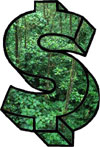
In 1776, the year the Scottish economist Adam Smith invented free-market economics with his book The Wealth of Nations, the total population of the globe was less than 700 million people. The coal-hauling locomotives and steamships that were to drive the Industrial Revolution were still 30 years off. Free-market economic theory grew and flourished in an era of abundant natural resources, in which the commodities that were the most rare — and thus the most precious — were the products of human technology. Nature was so bountiful that economists could afford to leave her out of their calculations.
Fast-forward to 2003. The world’s population has increased nearly tenfold. We are awash in technology, but our natural resources are rapidly dwindling. No longer can we rely on the infinite bounty of nature to provide healthy soil, clean air, and potable water. Yet even as the value of the environment to society becomes more and more apparent, so also does the inability of markets to recognize that value.
And it’s easy to see why. Compared to pork bellies and Palm Pilots, most goods and services provided by the environment are peculiar and ill-behaved: They don’t respect property rights, they may take millennia to turn a profit, they benefit those who pay for them and those who don’t alike. Neoclassical economists — the intellectual scions of Adam Smith — have generally been content to treat the environment as a particularly vexing sector of the overall economy, developing a group of theories collectively known as environmental economics to sort out the thorny problems presented by goods that don’t fit the market mold.
But recently, a group of mavericks known as “ecological economists” have begun to hammer out a new paradigm that stands economic theory on its head. Rather than the environment being a subset of the economy, they argue, the market is a subset of the global environment, and all the goods and services we trade ultimately depend on natural resources and processes. Ecological economists, while still personae non gratae in most university economics departments and major economic policy-setting institutions, are slowly gaining in influence, both in academia and among the general public.
In a special series, we profile three practitioners of the new science:
- Robert Costanza, director of the Gund Institute for Ecological Economics and the man who became famous for putting a price tag on the biosphere. In 1997, Costanza was lead author of a paper that declared the value of the services provided by the world’s ecosystems to be almost twice that of the combined GNPs of all the nations of the world. The study made international news, prompting headlines like “How Much is Nature Worth? For You, $33 Trillion.”
- Joshua Farley, a researcher at the Gund Institute for Ecological Economics, and a staunch crusader for the new paradigm. In 1996, Farley prized a doctorate in economics from the clutches of a committee of old-guard economists. Now he is making it his mission to literally rewrite the book for the next generation, coauthoring (with Herman Daly) the first textbook in ecological economics.
- Herman Daly, the founding father and reigning guru of ecological economics. A former insider at the World Bank who is now one of its sharpest critics, Daly is the co-founder of the journal Ecological Economics and author of over 100 books and articles, including Steady-State Economics and Beyond Growth.

